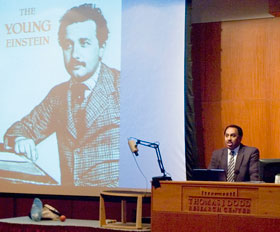  |
| HOME | THIS ISSUE | CALENDAR | GRANTS | BACK ISSUES | < BACK | NEXT > |
Physics prof outlines ABC’s of Einsteinby Elizabeth Omara-Otunnu - September 12, 2005 |
||||
|
When Ron Mallett was 12 years old, he used to spend his lunch money on books. Among them was one called The Universe and Dr. Einstein, which – along with H.G. Wells’ The Time Machine – kindled the young Mallett’s imagination, setting him on a path that eventually brought him to the physics faculty at UConn. Last week, Mallett sought to inspire non-specialists with a presentation titled “Einstein for Beginners,” a lecture in the Einstein Centennial series and one of the events in General Education Month. “Einstein had a great passion for physics and for trying to understand the fundamentals of the physical universe,” he said, addressing an audience of mostly students in Konover Auditorium Sept. 7. Philosophy professor Ann Hiskes, associate dean of liberal arts and sciences, who introduced Mallett, said that it was appropriate during a month of events celebrating general education at UConn to reflect on the achievements of Albert Einstein and his “world-transforming” work in physics. “Creativity and invention often come when people combine ideas and perspectives from different disciplines, and that’s really what general education is all about,” she said. Einstein invented his theory of special relativity in 1905 by applying the theories of Ernst Mach, a logical positivist, said Hiskes, who specializes in the philosophy of science and the nature of space and time in theories of physics: “Without his background in the humanities, it’s possible Einstein may never have challenged or reinvented the accepted theories of physics.” Mallett set out to explain Einstein’s theory of relativity in language accessible to the layperson. The theory derived from his interest in a “simple problem of motion,” Mallett said. The problem is this: If a ball is thrown from a moving vehicle, the speed at which it moves will be increased or decreased by the speed at which the vehicle is traveling, depending on which direction the vehicle is going. Einstein reasoned that the same should apply to light. An experiment by two physicists in the late 19th century had found that the speed of light was not affected by the motion of the earth. Based on the equation ‘speed equals distance over time,’ Einstein argued that if the speed of light did not change no matter how fast an object was moving toward or away from the light source, what does change must be distance and time. Mallett showed a video clip of a device known as a light clock that demonstrates this. When the device is stationary, a beam of light bounces vertically from one mirror to another, causing the clock to tick at even intervals. When the clock is moved, the beam continues to move at the same pace, but it moves along a zigzag path which is longer, so that it takes more time, and the clock ticks more slowly.
“These puzzling results couldn’t be explained prior to Einstein,” he said. The earth is constantly being bombarded by cosmic rays, Mallett continued, that are partly made up of muons, a type of electron that lives only for a millionth of a second. These muons are created in the upper atmosphere, so theoretically they should not be visible at the earth’s surface. Traveling close to the speed of light, however, their inner clock slows down, so they can live up to 16 times longer than they normally would, enabling them to reach the earth, Mallett said. Time slows down and distances shrink. Similarly, he said, if humans could travel close to the speed of light, their heart rates would slow. If a twin were to take a trip into space on a rocket moving at close to the speed of light to a destination 25 light years away (50 light years there and back), leaving the other twin on earth, the space traveler might age only 10 years or so because his metabolism would be slowed, while the earthbound twin would age 50 years. “When we develop rockets that can go close to the speed of light, we will see this happen,” said Mallett. “That’s special relativity.” Mallett also explained how Einstein reconciled Newton’s theory that gravity is instantaneous with the understanding that nothing travels faster than the speed of light. “Einstein said, ‘gravity is not really a force at all, gravity is an aspect of space,’” said Mallett. “If you introduce a massive object into empty space, the massive object bends the space and any other object moves into that region,” he continued. “By making curved space and gravity the same thing, Einstein was able to reconcile the speed of light with gravitational force. That’s general relativity.” Mallett, who joined the physics faculty in 1975, has published papers on black holes, relativistic cosmology and, recently, on time travel. Like Einstein, in addition to his passion for physics, he is interested in philosophy, music, and literature. |
| ADVANCE HOME UCONN HOME |

